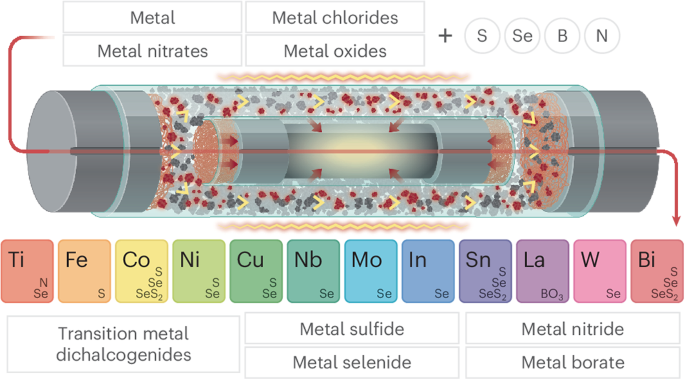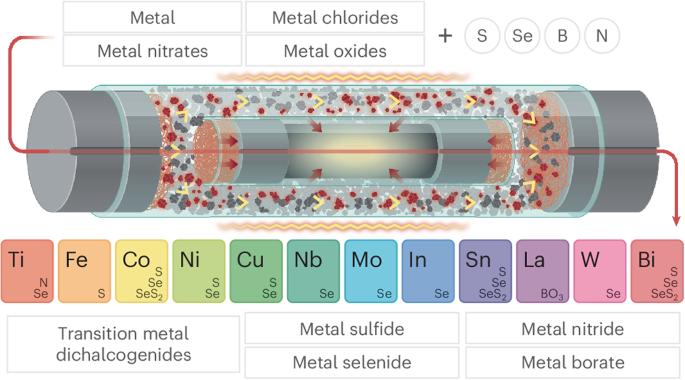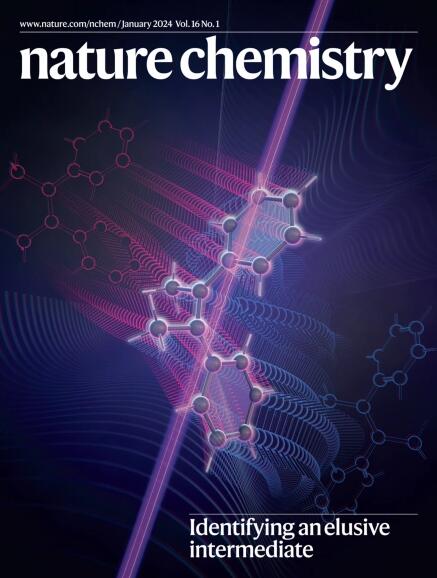克级固态材料的闪中闪合成。
IF 19.2
1区 化学
Q1 CHEMISTRY, MULTIDISCIPLINARY
引用次数: 0
摘要
在保持环保意识的同时,优先考虑能源效率、最小用水量、可扩展性和生成多样化材料的能力的可持续生产对于推进无机材料生产至关重要。然而,目前的生产实践还不能完全满足这些要求。在这里,我们介绍了一种闪中闪焦耳加热(FWF)技术--一种非平衡、超快的热传导方法--在环境条件下,在 5 秒内制备出 10 种过渡金属二钙化物、3 种第 XIV 族二钙化物和 9 种非过渡金属二钙化物材料。与其他合成方法相比,FWF 在快速克级扩展性和可持续生产标准方面具有巨大优势。此外,FWF 还能生产出相选择性和单晶块状粉末,这是其他合成方法很少能观察到的现象。此外,FWF MoSe2 在摩擦学方面的性能优于市售的 MoSe2,展示了 FWF 材料的品质。原子置换和掺杂能力进一步凸显了 FWF 作为通用块状无机材料合成方案的多功能性。本文章由计算机程序翻译,如有差异,请以英文原文为准。


Flash-within-flash synthesis of gram-scale solid-state materials
Sustainable manufacturing that prioritizes energy efficiency, minimal water use, scalability and the ability to generate diverse materials is essential to advance inorganic materials production while maintaining environmental consciousness. However, current manufacturing practices are not yet equipped to fully meet these requirements. Here we describe a flash-within-flash Joule heating (FWF) technique—a non-equilibrium, ultrafast heat conduction method—to prepare ten transition metal dichalcogenides, three group XIV dichalcogenides and nine non-transition metal dichalcogenide materials, each in under 5 s while in ambient conditions. FWF achieves enormous advantages in facile gram scalability and in sustainable manufacturing criteria when compared with other synthesis methods. Also, FWF allows the production of phase-selective and single-crystalline bulk powders, a phenomenon rarely observed by any other synthesis method. Furthermore, FWF MoSe2 outperformed commercially available MoSe2 in tribology, showcasing the quality of FWF materials. The capability for atom substitution and doping further highlights the versatility of FWF as a general bulk inorganic materials synthesis protocol. The scalable, energy-efficient and environmentally friendly production of solid-state materials is crucial for next-generation material synthesis. Now an efficient and gram-scale synthesis of transition metal dichalcogenides, group XIV dichalcogenides and non-transition metal dichalcogenides has been achieved using the flash-within-flash heating technique, a non-equilibrium, ultrafast heat conduction method.
求助全文
通过发布文献求助,成功后即可免费获取论文全文。
去求助
来源期刊

Nature chemistry
化学-化学综合
CiteScore
29.60
自引率
1.40%
发文量
226
审稿时长
1.7 months
期刊介绍:
Nature Chemistry is a monthly journal that publishes groundbreaking and significant research in all areas of chemistry. It covers traditional subjects such as analytical, inorganic, organic, and physical chemistry, as well as a wide range of other topics including catalysis, computational and theoretical chemistry, and environmental chemistry.
The journal also features interdisciplinary research at the interface of chemistry with biology, materials science, nanotechnology, and physics. Manuscripts detailing such multidisciplinary work are encouraged, as long as the central theme pertains to chemistry.
Aside from primary research, Nature Chemistry publishes review articles, news and views, research highlights from other journals, commentaries, book reviews, correspondence, and analysis of the broader chemical landscape. It also addresses crucial issues related to education, funding, policy, intellectual property, and the societal impact of chemistry.
Nature Chemistry is dedicated to ensuring the highest standards of original research through a fair and rigorous review process. It offers authors maximum visibility for their papers, access to a broad readership, exceptional copy editing and production standards, rapid publication, and independence from academic societies and other vested interests.
Overall, Nature Chemistry aims to be the authoritative voice of the global chemical community.
 求助内容:
求助内容: 应助结果提醒方式:
应助结果提醒方式:


